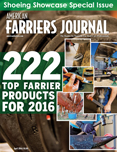Advertise Follow Us
American Farriers Journal

View Archived Issues
April 2016
Volume: 42
Edition: 3
American Farriers Journal is the “hands-on” magazine for professional farriers, equine veterinarians and horse care product and service buyers.
-
Table Of Contents
Table Of Contents
Eliminating Mistakes and Fallacies When Using Glue
Trio of farriers share their knowledge for better adhesive outcomesRead More13 Gluing Tips That Will Stick With You
Grand Slam farrier offers ideas to improve your glue-on successRead MoreKeep Your Rasps Sharp And Save
Pennsylvania farrier suggests two techniques to give your tool longer lifeRead MoreSolid Solution For Safety
Presentation provides insight on proper use and application of sedativeRead MorePerformance And Conformation
At higher levels of competition, understanding how a horse is put together becomes increasingly importantRead MoreSuccess With Hoof Testers Requires A Systematic Approach
An open discussion of this veterinarian-farrier tool results in ideas on avoiding common mistakesRead MoreBody Condition Scoring System Keeps Equine Professionals On The Same Page
This standardized method to determine a horse’s ideal body weight is an important tool for horse owners, trainers, farriers and nutritionistsRead MoreFarrier Q&A: April 2016
What is the best tool modification that you use? What are the steps involved in doing this?Read MoreFarrier Licensing: Just The Facts
What does registration, certification and licensing mean for the horseshoeing industry?Read MoreA Unique Approach to Frog Support
Rethinking the application of a pad results in a beneficial application for 3-day eventersRead MoreVideo ReviewDraft Horse Trimming, Shoeing Lessons Spelled Out
Tips And Techniques For Shoeing The Draft Horse With Michael Wildenstein, CJF, FWCFRead MoreHoof Protection Options For The Long Run
Vettec representative reviews the top three appliances that dominate endurance racingRead MoreBoots Gain Favor With Endurance Riders
By understanding the use and application of hoof boots, you can better address the needs of endurance clientsRead More3D Horseshoe Technology Making Strides
Oregon farrier finds perfect fit for horses with foot problemsRead MoreDiscuss Climate and Environment With Your Owners
Taking time to educate novice horse owners on better horse care can save you headaches down the roadRead MoreResearch Journal: April 2016
The information, ideas and opinions expressed are those of the author and do not necessarily represent those of the United States Department of Agriculture.Read More -
Featured Articles
Featured Articles
40 Ideas To Build A Better Business
Three farriers share tips to help you improve your backyard horse practiceRead MorePerformance And Conformation
At higher levels of competition, understanding how a horse is put together becomes increasingly importantRead More - Digital Edition
-
Online Extras
Online Extras
Web-Exclusive FeatureHands-On Session Delivers Tips On Gluing On Shoes
Farrier Travis Burns delivers practical tips for application at the 45th American Farrier’s Association ConventionRead MoreHow Reliable Is The Use Of Hoof Testers?
Researchers take the first step in a comparison of learning more about the consistency of this instrument’s usageRead More
















